What to Wear Hiking in Fall
These are my favorite clothes for hiking in the fall weather that are breathable, wick sweat, warm, weatherproof, and look good.
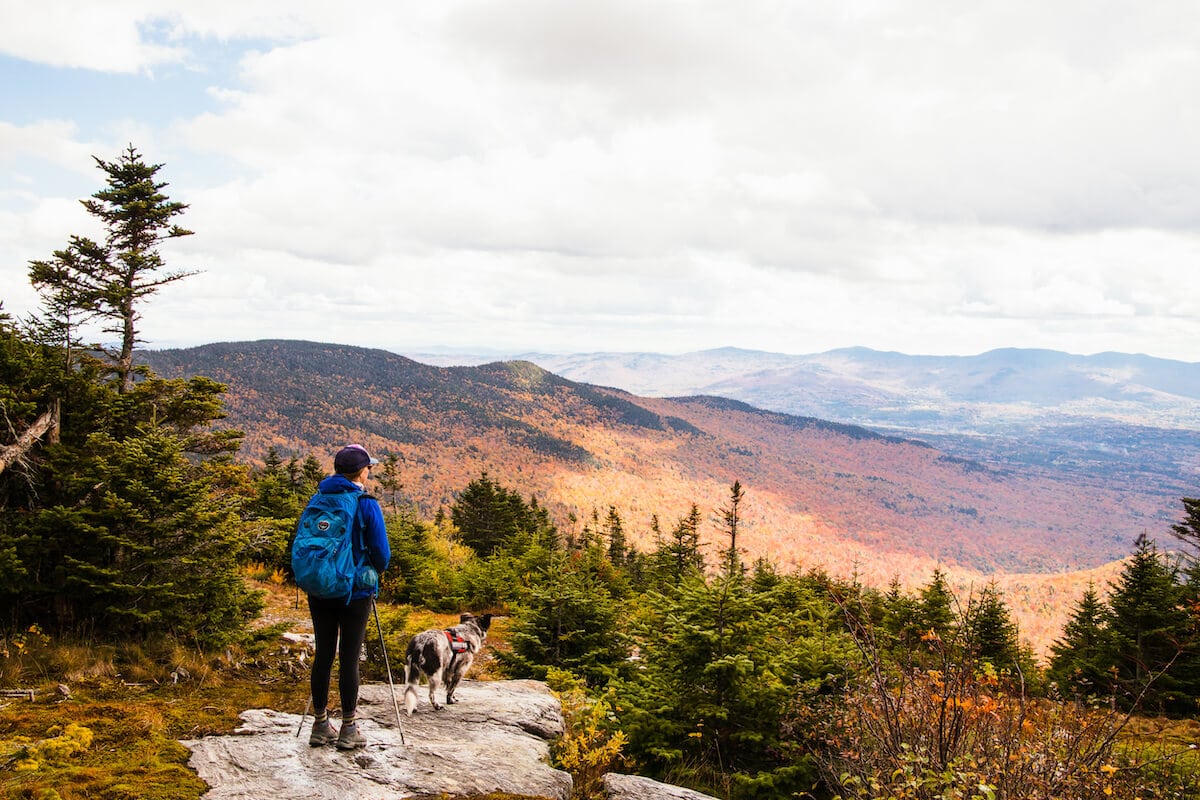
While hiking in the fall, you have to be prepared for all kinds of erratic weather conditions. In September and October, I’ve started hiking at the trailhead when it’s been sunny and beautiful, only to find myself hiking in freezing rain two hours later.
These experiences have taught me exactly what to wear hiking in the fall and the importance of being prepared with the right combination of layers – from breathable base layers to a warm jacket and rain gear.
It may be a little tricky to find a good balance of warmth and breathability at first, but there’s a simple method I’ve learned, which I’ll dive into below, that’ll help you nail it every time.
The layers and clothing I share in this post are the pieces I wear (or bring in my pack) on all of my fall activities, whether it’s a day hike or an overnight backpacking trip. Read on to learn all about layering and dressing for cooler conditions, plus how to stay prepared for changes in the weather.
This post may contain affiliate links.
Best Fabrics for Fall Hiking Clothes
The fabrics you choose for fall hiking make a huge difference in your comfort. I personally prefer synthetic materials like nylon and polyester. These are breathable, wick sweat, and clean up easily in the washing machine.
Merino wool blends are also a great choice, although these pieces sometimes require special washing instructions. I also find that merino clothing is a magnet for dog hair.
No matter what, you should avoid cotton and denim. If you get caught in an unexpected rainstorm, cotton and denim take forever to dry and get very heavy, leaving you cold and unprotected from the elements.
The best fabrics for fall hiking clothes will keep you insulated, but not hot, and have enough breathability so you’re comfortable no matter which way the weather turns. The key is to layer using the method I’ll talk about below and to always be prepared if the conditions change.

Save this post!
Enter your email & I'll send this post to your inbox! You'll also receive my weekly newsletter full of helpful advice for planning your adventures.
Fall Hiking Tops
On the top half of your body, you’ll want to have a good layering system that consists of a shirt, mid-layer, an insulating jacket, and a rain shell.
Base Layer / Hiking Shirt
A good base layer will do two things: keep you warm and regulate your body temperature. This way, you won’t overheat or become hypothermic while wearing wet clothes that cling to your body.
These pieces are the building blocks of a fall hiking outfit (and winter hiking outfits, too) because they are closest to your body and are easy to add on to as needed.
My favorite hiking shirt is the Patagonia Capilene Cool Daily Shirt. I own this in several colors and wear them on all my hikes, no matter the season. The fabric dries quickly and pulls moisture away from the skin, so you never feel soggy or wet.
This shirt also comes in a long-sleeved version. I often choose long-sleeves both for sun protection and to cut the wind while hiking in the fall.

Mid-Layer
Next, you’ll want a mid-layer that you can throw on top of your shirt in case you get a little chilly. Here are a few of my current favorite mid-layers for fall hiking:
- Patagonia R1 Zip Neck Pullover: The half-zipper gives you coverage or ventilation, depending on the conditions. It’s fitted but not too snug and is easy to layer over a short-sleeved t-shirt without feeling too tight (although you should size up if you prefer a looser fit).
- FarPointe Alpha Cruiser: This mid-layer is incredibly popular among thru-hikers due to the fact that it weighs less than 5 oz. I don’t even notice it in my pack. It wicks sweat exceptionally well and provides a ton of warmth for its weight. You do have to be careful with this though. It snags easily if you’re bushwhacking or have pets.
- Icebreaker 260 Tech Half Zip Thermal Top: If you prefer wool over synethic materials, Icebreaker makes my favorite merino wool layers. This half-zip is super cozy, doesn’t itch like some wool tops, and can be worn many times before it needs to be washed. Just be sure to follow the washing instructions. I’ve ruined a few of my Icebreaker pieces after accidentally shrinking them in the dryer.
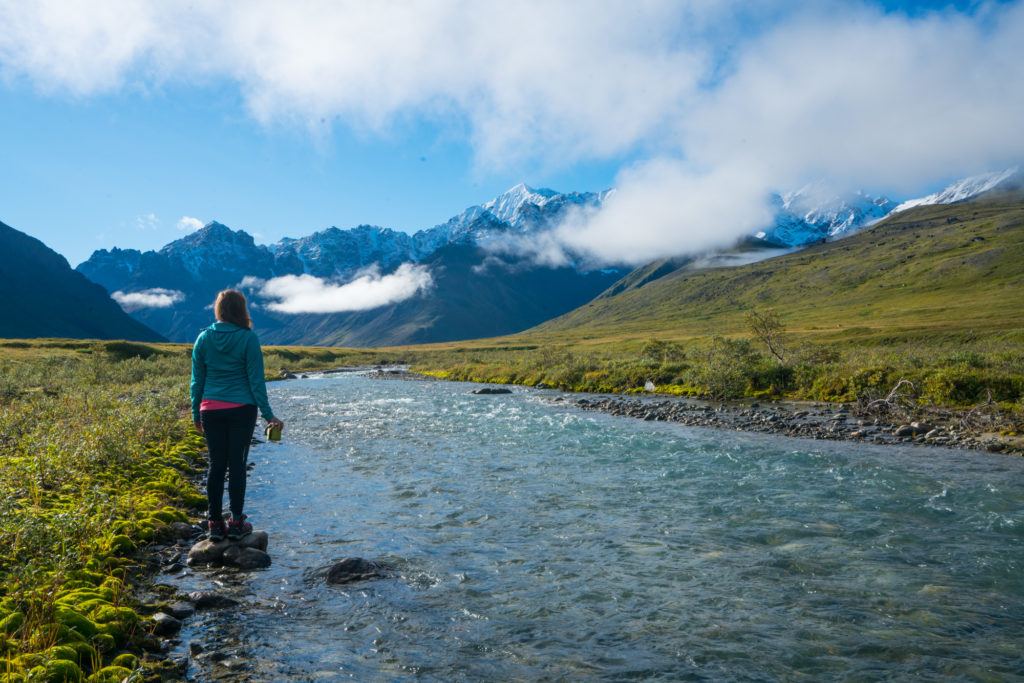
Insulating Jacket
Even if you typically run hot, packing an outer layer will prepare you for any sudden changes in the fall weather. Remember the sun also goes down behind the mountains earlier in fall so it gets chillier earlier in the afternoon.
I’d avoid down and opt for synethic materials instead. Down gets soggy quickly if it gets wet and won’t keep you warm. I also like jackets with a hood that I can pull over my head if it gets really windy.
These are my two favorite synthetic jackets for hiking in fall.
- Patagonia Nano Puff: This is a great year-round layer that is especially good in the fall. It’s not too hot or heavy, comes in lots of fun colors, and I have full range of motion when hiking in this jacket. It’s not as breathable as the Arc’teryx jacket I mention next, but I prefer the fit. For more info, read my full Patagonia Nano Puff Review.
- Arc’teryx Atom Insulated Hoodie: This was my go-to jacket until my dog chewed it up. This lightweight jacket feels like you are wearing a cloud, and I barely notice when it’s on. I feel like it does an excellent job of regulating my temperature, and I don’t overheat in it the second the sun comes out. It has an athletic fit, so if you’re in between sizes, I recommend sizing up.
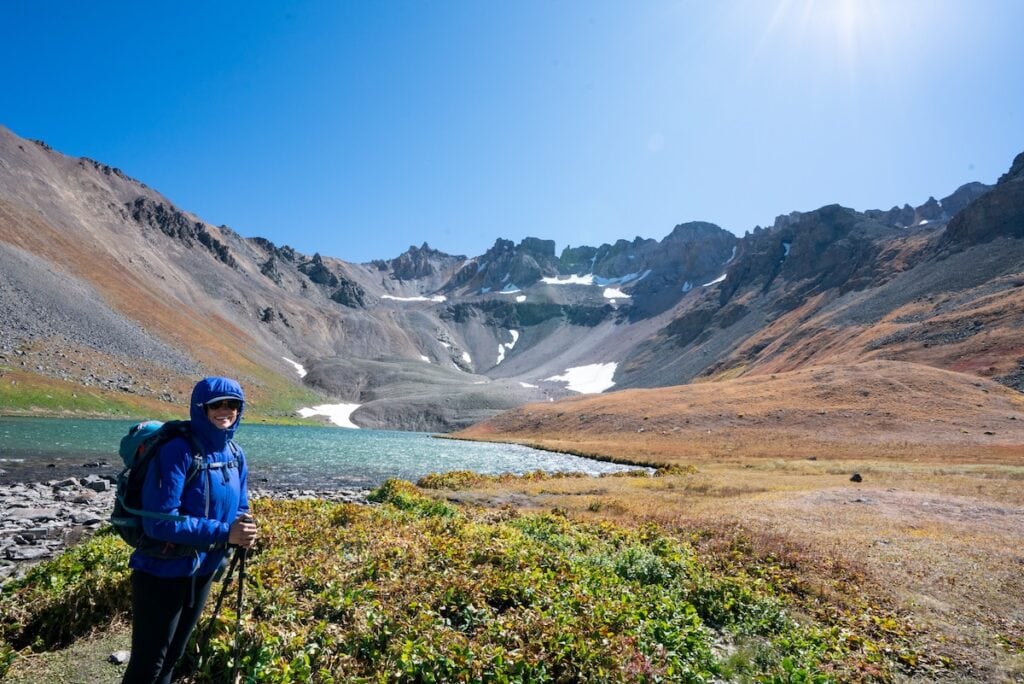
Fall Hiking Pants
If it’s a warm, sunny fall day, you can wear whatever hiking pants you typically wear in summer. However, as the weather gets colder, you’ll want to upgrade your hiking pants to something that provides a little more warmth.
Here are the pants I wear on fall hikes:
- lululemon Fast and Free High-Rise Thermal Tight 28″: These are so comfortable I could live in them in the cooler months. They are fleece lined, high waisted leggings with pockets big enough for your phone that provide a bit more insulation than a pair of standard leggings.
- Gnara GoThere Pants: These are a more traditional hiking pant with a DWR coating that will keep you legs dry if it starts to drizzle. A really cool feature of these pants is that they unzip in the crotch area, so you don’t have to pull them down when you have to pee. You just unzip, squat, pull your underwear to the side and go. This is super handy if you get caught in bad weather. They also roll up at the bottom if you get hot.
- REI Activator Pants: These also have a DWR finish that helps the water bead up and roll off the pants rather than soaking through. I especially love the waistband on these. It’s partially elastic so it’s comfortable and moves with your body.

Rain Gear
The fall season can bring unpredictable weather, which makes rain gear an essential clothing item on most fall hikes.
Rain Jacket
Whatever you do, make sure your rain jacket has pit zips that will help you air out if you end up hiking for a long distance in your rain jacket.
Here are a few different rain jackets to consider based on your budget. More more recommendations, see my post on the best lightweight rain jackets.
- Arc’teryx Beta SL: If you plan to hike frequently in crappy weather, the Arc’teryx Beta SL is worth the investment. It’s 3-layered GORE-TEX in a super light package that can stand up to the worst weather possible with an awesome hood, huge pit zips, and a RECCO® reflector that can help emergency responders find you if you get lost or have an accident. Get all the details in my Arc’teryx Beta SL Review.
- REI Rainier Rain Jacket: This is a 2.5 layer no-frills, budget-friendly rain jacket made of rip-stop nylon that will do the trick if you get caught in unexpected rain. It’s not the most breathable, but for the occasional use, it’s a good choice.
- Patagonia Torrentshell: A solid rain jacket at a middle price point. It has pit zips, an adjustable hood, and performs really well in heavy rain.
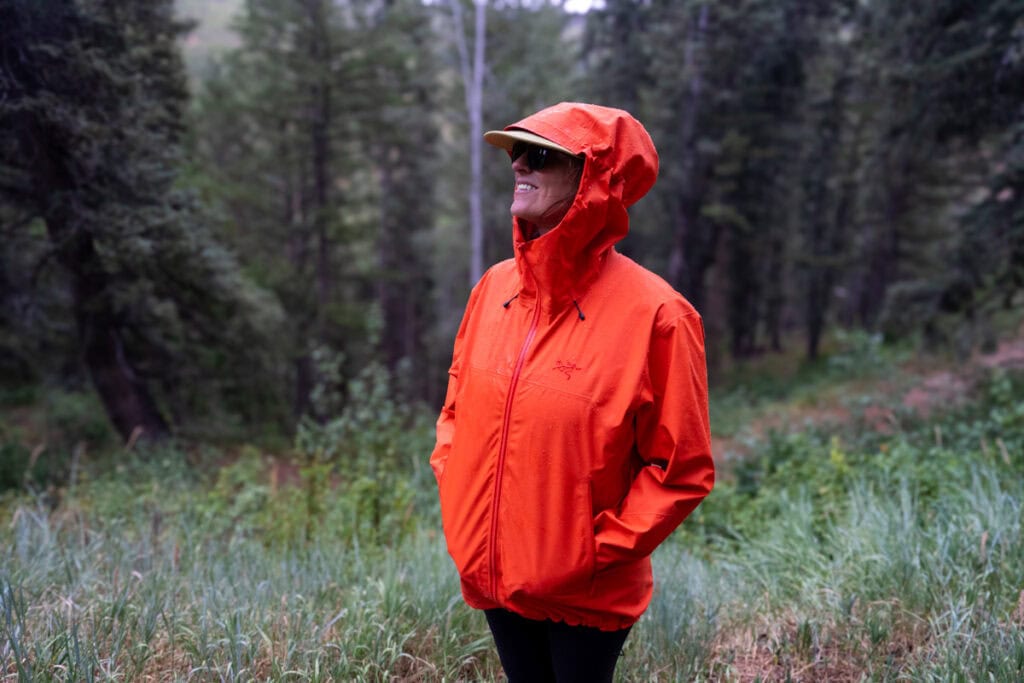
Rain Pants
If rain looks likely based on the forecast, I will bring rain pants with me in my pack. You don’t need anything special. I just look for rain pants that have a zipper on the lower leg so I don’t have to take my hiking boots off to get the rain pants on.
Fall Hiking Accessories
Gloves
Toss a pair of gloves in your pack to complete your fall hiking outfit and keep your fingers toasty. On cold mornings or on mountaintops, these Outdoor Research gloves provide a lightweight, warm layer. As a bonus, they’re touch-screen compatible so you can still use your phone or GPS device to take photos or navigate while you are hiking.
Beanie
Is your fall hike surprisingly chillier than you thought it would be? Find yourself in a windy spot for lunch? Pull on a cozy beanie to keep your ears and head warm.

Buff
Made from recycled polyester, I learned just how versatile the Buff is on my Everest Basecamp Trek a few years ago. When the wind started to howl I just pulled the Buff up over my neck, mouth, and nose and I was a lot more comfortable.
I also used one in Patagonia when hiking the W Trek in Torres del Paine. Wearing it as a headband over my hat, the Buff served as an ear warmer and prevented my hat from blowing away in the wind. It has a UPF rating of 50, so it even provides sun protection.

Footwear
Hiking Socks
While you should say no to cotton socks all year round, it’s even more important in cooler, wetter months to wear wool or a comparable synthetic on your feet. Wool socks are much better at regulating temperature, wicking away sweat, and keeping your feet dry in rainy conditions.My go-to for hiking socks? Darn Tough all day long.
Waterproof Hiking Boots
In the fall, you should choose waterproof hiking boots over non-waterproof shoes (you can learn about the pros and cons of waterproof boots here). Wet feet might not be a deal breaker in the summer, but in the fall when temps drop, soggy boots can be a serious problem resulting in numb toes or gnarly blisters.
I also recommend a mid to high-ankle shoe. The conditions can be more slick in the fall and having that added ankle support can help prevent injuries.
Here are 2 of my favorite waterproof hiking boots for fall hiking. I have a lot more suggestions in my roundup of the best women’s hiking boots.
- Oboz Bridger Mid-Hiking Boots: If you are looking for a beefier, extremely supportive boot that can handle heavy loads, I highly recommend the Oboz Bridger Mid. I’ve worn mine for hundreds of miles in all kinds of weather while carrying a very heavy pack. My feet are always dry, blister-free, and comfortable.
- Oboz Katabatic Mid Waterproof Hiking Boots: If you want a lighter-weight shoe, I love the Oboz Katabatic. I feel really nimble in these, the sole is super grippy, and they provide adequate cushion on a majority of trails.
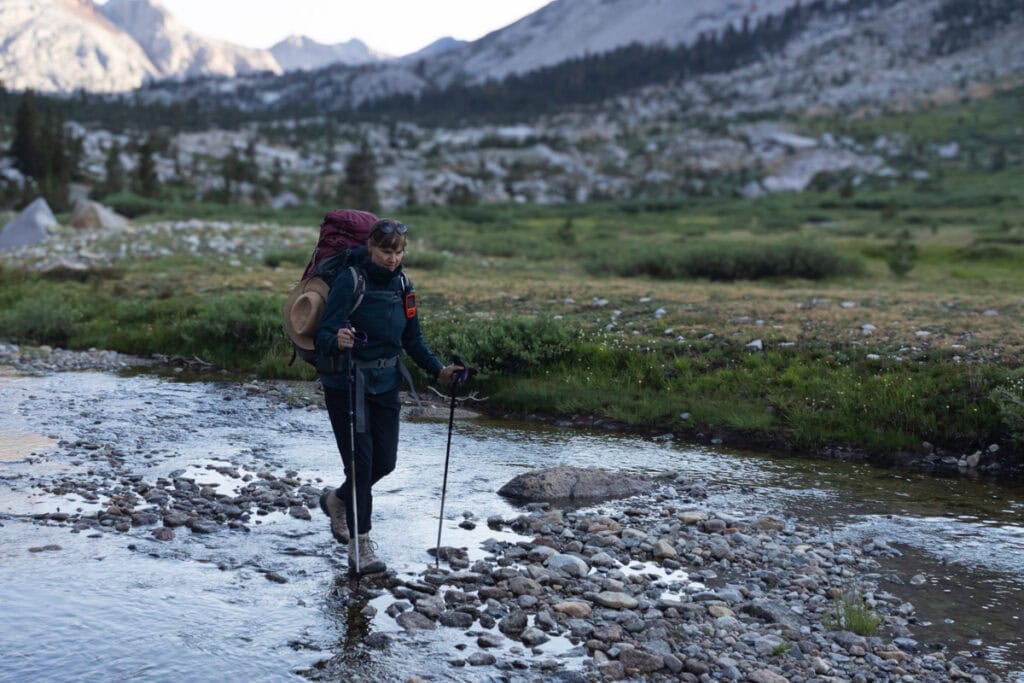
More Fall Tips
What are your favorite clothes and layers to wear hiking in the fall? Let us know in the comments below!


Love this. I never realised how important proper socks were until I was given a pair of smart merino wool socks… literally in my bag every time I go camping now!! Affectionately called “sacred socks”!
Fantastic tips! Fall is my favorite time to go hiking, I’ve recently started setting up trail cameras to try to capture some local elk photos. I’ll have to keep these tips in mind for next year, it’s already too cold for me to keep going out there. https://www.critterlick.com/
Wow….thank you so much!
Thanks for reading! Happy hiking 🙂
Hello. I’m looking for plus size hiking outfits. Any suggestions?
Yes! Jenny Bruso of Unlikely Hikers has a great plus size activewear guide: https://jennybruso.com/plussize/
This was really great information. I’m going for my first hike this weekend. Now I’ll be properly prepared. Many thanks!
Glad you found it helpful, enjoy your hike!
Thank you Kristen!
I’ve been looking for proper socks for quite some while.
So far I’ve only been layering my socks instead of getting proper wool socks. My tip for clothing and especially hiking boots is to impregnate it very well. As the trails can be really muddy in fall, I HATE cleaning my boots afterwards.
So I impregnate them with a nano coating from nano care: https://nano-care.com/products/nano-coating/ and the dirt washes off so much easier!
Thanks for that tip Steffen!
Kristen
I work at an REI in softgoods and footwear and I concur on every item. The Arcteryx Atom jacket is sensational. Oboz, for many customers I encounter, is an unknown but once the customer tries it on, more often than not, they’re sold. It’s all about how it fits and the performance.
Thanks for chiming in!
Great read overall, and pretty good gear picks! I’ve learnt about necessity of proper layering during hunting with my dad. Trust me, last thing you wanna do in Fall(or winter for that matter) is find yourself freezing in the hunt stand with many miles separating you from you camp. Mess up like that 1 or 2 times and you never going to forget about proper layering 😀 Not really hunting anymore and switched to more of camping/hiking routine, but still using mostly hunting clothes(usually from https://gritroutdoors.com/apparel/hunting-clothing/ since I find it pretty warm and I don’t really mind the camo). Recently even picked up a new Browning Jacket+ pants, still have my Arcteryx hoodie. Should be more than enough for early fall.
You definitely learn pretty quickly being cold in the outdoors! Thanks for reading & sharing your tips.